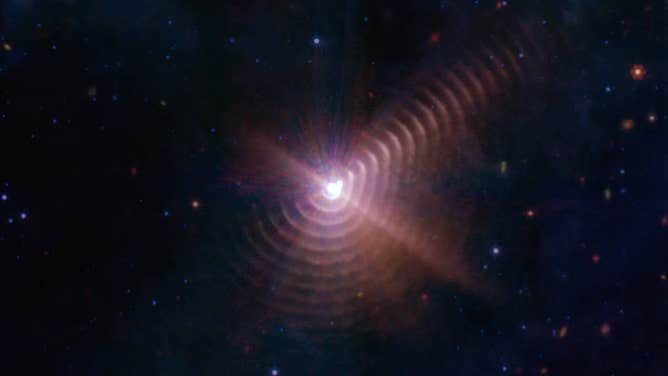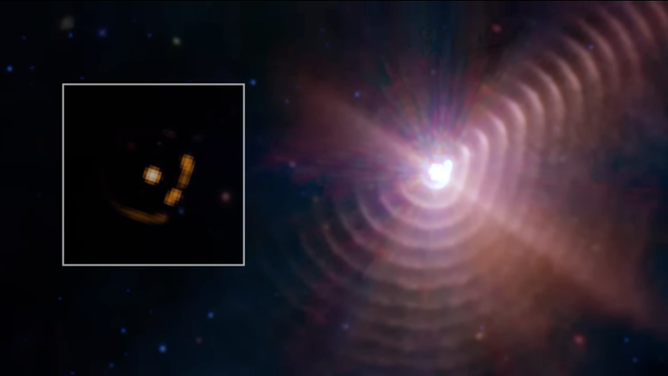Star duo creates a 'fingerprint' in space captured by James Webb Space Telescope
Similar to rings on a tree trunk, NASA said each ring marks another meeting of the stars. Scientists believe at least 17 rings are emanating from the pair of stars.

The two stars in Wolf-Rayet 140 produce shells of dust every eight years that look like rings, as seen in this image from NASA’s James Webb Space Telescope. Each ring was created when the stars came close together and their stellar winds collided, compressing the gas and forming dust. (Image credits: NASA, ESA, CSA, STScI, JPL-Caltech)
Two stars bumping hips 5,300 light-years from Earth are sending stellar gas out into space, creating a thumb-print-like impression for NASA's most powerful space telescope to observe.
NASA's James Webb Space Telescope continues to reveal stunning never-before-seen views of the universe since it began scientific operations this summer.
This week, NASA and the European Space Agency teams shared another wonderful image only made possible by Webb. According to NASA, about every eight years, the star duo known as Wolf-Rayet 140 (WR 140) comes close together, and as the stars' stellar winds meet, it produces dust rings or shells.
Similar to rings on a tree trunk, NASA said each ring marks another meeting of the stars. Scientists believe at least 17 rings are emanating from the pair of stars. The JWST image looks like a fingerprint in space.
JAMES WEBB SPACE TELESCOPE IMAGES WOW BY SHOWING STAR NURSERY, GALAXIES IN A COSMIC DANCE
Before using Webb's Mid-Infrared Instrument (MIRI) to study Wolf-Rayet 140, only two dust rings were visible when using ground-based telescopes, according to Ryan Lau, an astronomer with National Science Foundation's NOIR Lab.

Previous image on the left of Wolf Rayet 140 and the new image from the James Webb Space Telescope. (Image: NASA, ESA, CSA, STScI, JPL-Caltech
"We’re looking at over a century of dust production from this system," said Lau, the lead author of a new study about Wolf-Rayet 140 published in Nature Astronomy.
Wolf-Rayet star is an O-type star that generates winds that push gas into space, and according to NASA, WR 140 may have shed more than half of its original mass through these winds.
This star duo is unique because while other Wolf-Rayet stars emit dust, no others have been found to produce the rings that Webb observed at Wolf-Rayet 140. As the stars shed mass, they also eject carbon and other elements into space.
JAMES WEBB SPACE TELESCOPE CAPTURES JUPITER'S SWIRLING WEATHER, COLORFUL AURORAS AND RINGS
According to the new study, researchers believe WR 140's winds are sweeping away residual material leaving the rings pristine for Webb to see. There may be even more rings, but they are too faint even for the powerful JWST.
The James Webb Space Telescope began its first scientific observations in July when NASA, the European Space Agency and the Canadian Space Agency released a handful of test images and data the telescope took to show off its potential.